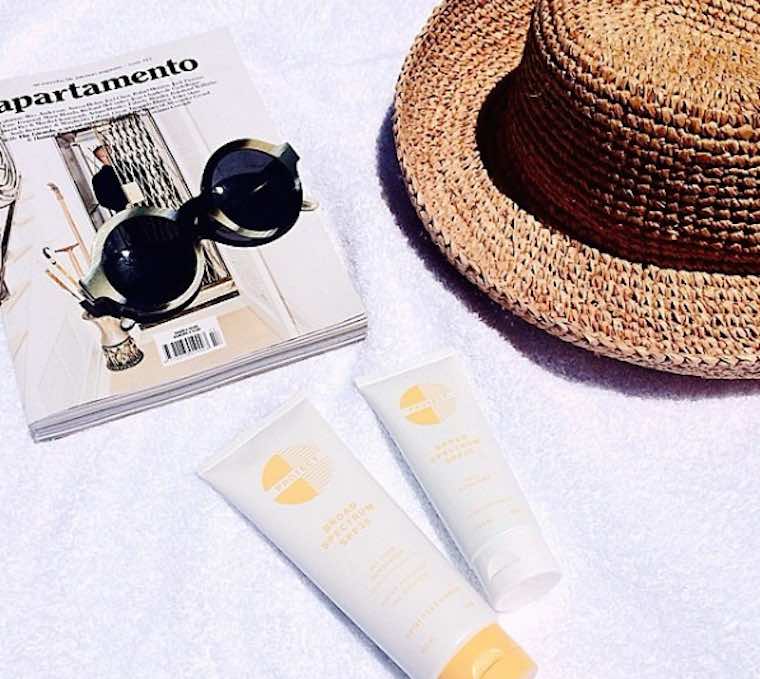10 Things You Probably Don’t Know About Sunscreen (but Really Should)
That's happening today, with the debut of the EWG's 11th annual guide, which famously lists the organization's picks for best and worst sunscreens. They review hundreds of products, scanning the label for clean and not-so clean ingredients (such as known hormone disruptors and allergens), and give each product a toxicity rating, with a score of 1 being the best.
Because nobody wants to unknowingly put crap on their skin—or stay indoors all summer, we chatted with EWG Senior Analyst Sonya Lunder about the key things you should know about sun protection right now. —Additional reporting by Rachel Lapidos
Here are 10 things you might be surprised to know about sunscreen—but totally should—and non-toxic EWG product picks:
1. You're probably not putting enough sunscreen on. Mineral sunscreens like zinc oxide and titanium dioxide are typically thicker in appearance, so people often think they are putting on enough when they’re actually not. Pay closer attention when using these sunscreens to ensure you’re properly covered. The Skin Cancer foundations says 1 ounce (get out your shot glass), every two hours. You should drain half a bottle on a long beach day.

{{post.sponsorText}}
2. Look out for oxybenzone. It's a very common ultraviolet filtering ingredient used in many sunscreens, but it's also a hormone disruptor and an allergen, says Lunder. EWG found it in 70 percent of non-mineral sunscreens they evaluated this year. You might want to reach for sun protection with zinc oxide and titanium dioxide (both minerals), which are considered safer sunscreen ingredients.
3. Extremely high SPFs (above 50) are totally misleading. Lunder, and many of her chemist counterparts, agree that these products don’t likely offer better sun protection at all, so people are inadvertently frying themselves. This year, EWG found 61 products claiming to have an SPF of 70 or higher, and 15 advertised as above 100. Even the FDA says they "do not have adequate data demonstrating that products with SPF values higher than 50 provide additional protection." For now, stick with one in the 30-50 SPF range.
4. Sunscreen sprays may be easier to apply but are way more dicey. You're less likely to apply an even or thick enough coating on your skin for proper sun protection, plus the air-born minerals and chemicals "pose an inhalation risk," says Lunder. Bummer.
5. Stay clear of vitamin A (retinyl palmitate) in your sunscreen. Many sunscreens use vitamin A, which is a moisturizing antioxidant with a solid anti-aging track record in beauty products and is used in tons of face creams. But according to various governmental studies, the vitamin doesn't interact well with sunlight and may trigger development of cancerous skin lesions or tumors. The ingredient is also known as as retinol, retinyl palmitate, retinyl acetate, or retinyl linoleate.
6. Don’t use expired sunscreen. Hello, those dates on your sunscreen matter. Sunscreens typically last about two years unopened, but once you've cracked the lid, it's a case of use it or lose it. Also keeping it in your car (AKA sauna) could expedite the clumping and separation process which will make it no longer effective.
7. Your sunscreen should also protect you from UVA rays. Many sunscreens only provide UVB protection, since these rays cause burning. But your sunscreen should also help fend off seriously evil UVA rays. These don't burn skin. They pass right through it (and glass BTW), where they work stealthily and destructively, deep down in your dermis. That's where your new skin cells are produced, along with your elastin and collagen. The result? Sun spots, wrinkles, lack of firmness, and the like—at an undisclosed time in the future. Ingredients like zinc oxide and titanium dioxide help fend off both UVA and UVB. Avobenzone and Mexoryl offer UVA protection as well, according to Lunder.
8. Sunscreens that call themselves "sport" or "water-resistant" can be deceiving. The FDA doesn't allow brands to say sunscreens are “waterproof” or “sweatproof,” so brands think of creative ways to indicate it. If they use the permitted term of "water-resistant, companies must indicate whether it's for 40 or 80 minutes. Still, it’s almost impossible to gauge their accuracy, says Lunder. She (probably along with every dermatologist) says to re-apply sunscreen as soon as you get out of the water, towel off, or at least every two hours.
9. Moisturizers typically have less UV protection. And, according to Lunder, the SPF protection in moisturizers don't last all day, so be sure to use a real sunscreen if you're in the sun. Check the EWG Guide on the products they tested.
10. A common misconception is that using sunscreen alone prevents skin cancer. This is sadly not the case. There’s just no proof, says Lunder, and melanoma has tripled over the past 35 years. Sun-protective clothing is your best bet, says Lunder. And may we also recommend this cute UPF fabric beach tent for your next seaside outing...

And the 10 best sunscreens that scored a 1 by EWG...
1. All Good Sport Sunscreen, $12
2. Block Island Organics Natural Mineral Sunscreen, $20
3. Beautycounter Protect All Over Sunscreen, $32
4. Burt's Bees Baby Bee Sunscreen Stick, $18
5. Suntegrity Skincare Natural Mineral Sunscreen for Body, $24
6. Raw Elements USA Eco Formula, $16
7. Butterbean Organics Simple Healthy Sunscreen, $19
8. Juice Beauty Sport Sunscreen, $16
9. COOLA Suncare Baby Mineral Sunscreen Unscented Moisturizer, $36
10. Badger Sport Sunscreen Cream, $14
Originally published May 24, 2016. Updated May 24, 2017.
Now that you've got your skin covered, you might want to look into these 11 natural products that help summer beauty woes (ahem, humidity). And these juice recipes are super refreshing on hot days. And here are our favorites sunscreens to date...
Loading More Posts...